Near-Infrared Light Driven ZnIn2S4-Based Photocatalysts for Environmental and Energy Applications: Progress and Perspectives
Abstract
1. Introduction
2. Hybrid with Narrow Optical Gap Materials
3. Bandgap Engineering
4. Up-Conversion Materials
5. Surface Plasmon Resonance
6. Conclusions and Prospects
Author Contributions
Funding
Conflicts of Interest
References
- Fujishima, A.; Honda, K. Electrochemical Photolysis of Water at a Semiconductor Electrode. Nature 1972, 238, 37. [Google Scholar] [CrossRef] [PubMed]
- Dhakshinamoorthy, A.; Navalon, S.; Corma, A.; Garcia, H. Photocatalytic CO2 Reduction by TiO2 and Related Titanium Containing Solids. Energy Environ. Sci. 2012, 5, 9217–9233. [Google Scholar] [CrossRef]
- Hisatomi, T.; Kubota, J.; Domen, K. Recent Advances in Semiconductors for Photocatalytic and Photoelectrochemical Water Splitting. Chem. Soc. Rev. 2014, 43, 7520–7535. [Google Scholar] [CrossRef] [PubMed]
- Zhen, C.; Chen, R.; Wang, L.; Liu, G.; Cheng, H.M. Tantalum (Oxy)Nitride Based Photoanodes for Solar-Driven Water Oxidation. J. Mater. Chem. A 2016, 4, 2783–2800. [Google Scholar] [CrossRef]
- Wang, J.; Lin, S.; Tian, N.; Ma, T.; Zhang, Y.; Huang, H. Nanostructured Metal Sulfides: Classification, Modification Strategy, and Solar-Driven CO2 Reduction Application. Adv. Funct. Mater. 2021, 31, 2008008. [Google Scholar] [CrossRef]
- Yang, Y.; Que, W.; Zhang, X.; Yin, X.; Xing, Y.; Que, M.; Zhao, H.; Du, Y. High-Quality Cu2ZnSnS4 and Cu2ZnSnSe4 Nanocrystals Hybrid with ZnO and NaYF4: Yb, Tm as Efficient Photocatalytic Sensitizers. Appl. Catal. B Environ. 2017, 200, 402–411. [Google Scholar] [CrossRef]
- Yang, Y.; Que, W.; Zhang, X.; Xing, Y.; Yin, X.; Du, Y. Facile Synthesis of ZnO/CuInS2 Nanorod Arrays for Photocatalytic Pollutants Degradation. J. Hazard. Mater. 2016, 317, 430–439. [Google Scholar] [CrossRef]
- Fu, J.; Yu, J.; Jiang, C.; Cheng, B. G-C3N4-Based Heterostructured Photocatalysts. Adv. Energy Mater. 2018, 8, 1701503. [Google Scholar] [CrossRef]
- Ong, W.J.; Tan, L.L.; Chai, S.P.; Yong, S.T.; Mohamed, A.R. Surface Charge Modification via Protonation of Graphitic Carbon Nitride (g-C3N4) for Electrostatic Self-Assembly Construction of 2D/2D Reduced Graphene Oxide (RGO)/g-C3N4 Nanostructures toward Enhanced Photocatalytic Reduction of Carbon Dioxide to Methane. Nano Energy 2015, 13, 757–770. [Google Scholar] [CrossRef]
- Ong, W.J.; Tan, L.L.; Ng, Y.H.; Yong, S.T.; Chai, S.P. Graphitic Carbon Nitride (g-C3N4)-Based Photocatalysts for Artificial Photosynthesis and Environmental Remediation: Are We a Step Closer to Achieving Sustainability? Chem. Rev. 2016, 116, 7159–7329. [Google Scholar] [CrossRef]
- Trickett, C.A.; Helal, A.; Al-Maythalony, B.A.; Yamani, Z.H.; Cordova, K.E.; Yaghi, O.M. The Chemistry of Metal-Organic Frameworks for CO2 Capture, Regeneration and Conversion. Nat. Rev. Mater. 2017, 2, 17045. [Google Scholar] [CrossRef]
- Xu, H.Q.; Hu, J.; Wang, D.; Li, Z.; Zhang, Q.; Luo, Y.; Yu, S.H.; Jiang, H.L. Visible-Light Photoreduction of CO2 in a Metal-Organic Framework: Boosting Electron-Hole Separation via Electron Trap States. J. Am. Chem. Soc. 2015, 137, 13440–13443. [Google Scholar] [CrossRef]
- Banerjee, T.; Gottschling, K.; Savasci, G.; Ochsenfeld, C.; Lotsch, B.V. H2 Evolution with Covalent Organic Framework Photocatalysts. ACS Energy Lett. 2018, 3, 400–409. [Google Scholar] [CrossRef]
- Huang, N.; Wang, P.; Jiang, D. Covalent Organic Frameworks: A Materials Platform for Structural and Functional Designs. Nat. Rev. Mater. 2016, 1, 16068. [Google Scholar] [CrossRef]
- Chen, Y.; Huang, R.; Chen, D.; Wang, Y.; Liu, W.; Li, X.; Li, Z. Exploring the Different Photocatalytic Performance for Dye Degradations over Hexagonal ZnIn2S4 Microspheres and Cubic ZnIn2S4 Nanoparticles. ACS Appl. Mater. Interfaces 2012, 4, 2273–2279. [Google Scholar] [CrossRef]
- Wang, J.; Chen, Y.; Zhou, W.; Tian, G.; Xiao, Y.; Fu, H.; Fu, H. Cubic Quantum Dot/Hexagonal Microsphere ZnIn2S4 Heterophase Junctions for Exceptional Visible-Light-Driven Photocatalytic H2 Evolution. J. Mater. Chem. A 2017, 5, 8451–8460. [Google Scholar] [CrossRef]
- Tang, M.; Yin, W.; Zhang, F.; Liu, X.; Wang, L. The Potential Strategies of ZnIn2S4-Based Photocatalysts for the Enhanced Hydrogen Evolution Reaction. Front. Chem. 2022, 10, 959414. [Google Scholar] [CrossRef]
- Song, Y.; Zhang, J.; Dong, X.; Li, H. A Review and Recent Developments in Full-Spectrum Photocatalysis Using ZnIn2S4-Based Photocatalysts. Energy Technol. 2021, 9, 2100033. [Google Scholar] [CrossRef]
- Wang, J.; Sun, S.; Zhou, R.; Li, Y.; He, Z.; Ding, H.; Chen, D.; Ao, W. A Review: Synthesis, Modification and Photocatalytic Applications of ZnIn2S4. J. Mater. Sci. Technol. 2021, 78, 1–19. [Google Scholar] [CrossRef]
- Guo, X.; Liu, Y.; Yang, Y.; Mu, Z.; Wang, Y.; Zhang, S.; Wang, S.; Hu, Y.; Liu, Z. Effective Visible-Light Excited Charge Separation in All-Solid-State Ag Bridged BiVO4/ZnIn2S4 Core-Shell Structure Z-Scheme Nanocomposites for Boosting Photocatalytic Organics Degradation. J. Alloys Compd. 2021, 887, 161389. [Google Scholar] [CrossRef]
- Zhang, T.; Wang, T.; Meng, F.; Yang, M.; Kawi, S. Recent Advances in ZnIn2S4-Based Materials towards Photocatalytic Purification, Solar Fuel Production and Organic Transformations. J. Mater. Chem. C 2022, 10, 5400–5424. [Google Scholar] [CrossRef]
- Shen, J.; Zai, J.; Yuan, Y.; Qian, X. 3D Hierarchical ZnIn2S4: The Preparation and Photocatalytic Properties on Water Splitting. Int. J. Hydrogen Energy 2012, 37, 16986–16993. [Google Scholar] [CrossRef]
- Lin, B.; Li, H.; An, H.; Hao, W.; Wei, J.J.; Dai, Y.; Ma, C.; Yang, G. Preparation of 2D/2D g-C3N4 Nanosheet@ZnIn2S4 Nanoleaf Heterojunctions with Well-Designed High-Speed Charge Transfer Nanochannels towards High-Efficiency Photocatalytic Hydrogen Evolution. Appl. Catal. B Environ. 2018, 220, 542–552. [Google Scholar] [CrossRef]
- Yang, G.; Ding, H.; Chen, D.; Feng, J.; Hao, Q.; Zhu, Y. Construction of Urchin-like ZnIn2S4-Au-TiO2 Heterostructure with Enhanced Activity for Photocatalytic Hydrogen Evolution. Appl. Catal. B Environ. 2018, 234, 260–267. [Google Scholar] [CrossRef]
- Chen, Z.; Guo, F.; Sun, H.; Shi, Y.; Shi, W. Well-Designed Three-Dimensional Hierarchical Hollow Tubular g-C3N4/ZnIn2S4 Nanosheets Heterostructure for Achieving Efficient Visible-Light Photocatalytic Hydrogen Evolution. J. Colloid Interface Sci. 2022, 607, 1391–1401. [Google Scholar] [CrossRef]
- Xu, Z.; Shi, W.; Shi, Y.; Sun, H.; Li, L.; Guo, F.; Wen, H. Carbon Dots as Solid-State Electron Mediator and Electron Acceptor in S-Scheme Heterojunction for Boosted Photocatalytic Hydrogen Evolution. Appl. Surf. Sci. 2022, 595, 153482. [Google Scholar] [CrossRef]
- Cai, Y.; Shi, Y.; Shi, W.; Bai, S.; Yang, S.; Guo, F. A One-Photon Excitation Pathway in 0D/3D CoS2/ZnIn2S4 Composite with Nanoparticles on Micro-Flowers Structure for Boosted Visible-Light-Driven Photocatalytic Hydrogen Evolution. Compos. Part B Eng. 2022, 238, 109955. [Google Scholar] [CrossRef]
- Wang, J.; Shi, Y.; Sun, H.; Shi, W.; Guo, F. Fabrication of Bi4Ti3O12/ZnIn2S4 S-Scheme Heterojunction for Achieving Efficient Photocatalytic Hydrogen Production. J. Alloy. Compd. 2023, 930, 167450. [Google Scholar] [CrossRef]
- Shi, Y.; Li, L.; Xu, Z.; Qin, X.; Cai, Y.; Zhang, W.; Shi, W.; Du, X.; Guo, F. Coupled Internal Electric Field with Hydrogen Release Kinetics for Promoted Photocatalytic Hydrogen Production through Employing Carbon Coated Transition Metal as Co-Catalyst. J. Colloid Interface Sci. 2023, 630, 274–285. [Google Scholar] [CrossRef]
- Chen, K.; Shi, Y.; Shu, P.; Luo, Z.; Shi, W.; Guo, F. Construction of Core–Shell FeS2@ZnIn2S4 Hollow Hierarchical Structure S-Scheme Heterojunction for Boosted Photothermal-Assisted Photocatalytic H2 Production. Chem. Eng. J. 2023, 454, 140053. [Google Scholar] [CrossRef]
- Shi, Y.; Li, L.; Xu, Z.; Guo, F.; Shi, W. Construction of Full Solar-Spectrum Available S-Scheme Heterojunction for Boosted Photothermal-Assisted Photocatalytic H2 Production. Chem. Eng. J. 2023, 459, 141549. [Google Scholar] [CrossRef]
- Yang, G.; Chen, D.; Ding, H.; Feng, J.; Zhang, J.Z.; Zhu, Y.; Hamid, S.; Bahnemann, D.W. Well-Designed 3D ZnIn2S4 Nanosheets/TiO2 Nanobelts as Direct Z-Scheme Photocatalysts for CO2 Photoreduction into Renewable Hydrocarbon Fuel with High Efficiency. Appl. Catal. B Environ. 2017, 219, 611–618. [Google Scholar] [CrossRef]
- Xia, Y.; Cheng, B.; Fan, J.; Yu, J.; Liu, G. Near-Infrared Absorbing 2D/3D ZnIn2S4/N-Doped Graphene Photocatalyst for Highly Efficient CO2 Capture and Photocatalytic Reduction. Sci. China Mater. 2020, 63, 552–565. [Google Scholar] [CrossRef]
- Cheng, C.; Chen, D.; Li, N.; Xu, Q.; Li, H.; He, J.; Lu, J. ZnIn2S4 Grown on Nitrogen-Doped Hollow Carbon Spheres: An Advanced Catalyst for Cr(VI) Reduction. J. Hazard. Mater. 2020, 391, 122205. [Google Scholar] [CrossRef]
- Mu, F.; Cai, Q.; Hu, H.; Wang, J.; Wang, Y.; Zhou, S.; Kong, Y. Construction of 3D Hierarchical Microarchitectures of Z-Scheme UiO-66-(COOH)2/ZnIn2S4 Hybrid Decorated with Non-Noble MoS2 Cocatalyst: A Highly Efficient Photocatalyst for Hydrogen Evolution and Cr(VI) Reduction. Chem. Eng. J. 2020, 384, 123352. [Google Scholar] [CrossRef]
- Qiu, J.; Li, M.; Yang, L.; Yao, J. Facile Construction of Three-Dimensional Netted ZnIn2S4 by Cellulose Nanofibrils for Efficiently Photocatalytic Reduction of Cr(VI). Chem. Eng. J. 2019, 375, 121990. [Google Scholar] [CrossRef]
- Zhang, J.; Pan, Z.H.; Yang, Y.; Wang, P.F.; Pei, C.Y.; Chen, W.; Huang, G.B. Boosting the Catalytic Activity of a Step-Scheme In2O3/ZnIn2S4 Hybrid System for the Photofixation of Nitrogen. Chin. J. Catal. 2022, 43, 265–275. [Google Scholar] [CrossRef]
- Chen, S.; Xie, F.; Wang, X.; Zhao, X.; Tang, Z. Efficient Charge Separation between ZnIn2S4 Nanoparticles and Polyaniline Nanorods for Nitrogen Photofixation. New J. Chem. 2020, 44, 7350–7356. [Google Scholar] [CrossRef]
- Guo, L.; Han, X.; Zhang, K.; Zhang, Y.; Zhao, Q.; Wang, D.; Feng, F. Heterostructure with Enhanced Photocatalytic Activity for N2 Fixation and Phenol Degradation. Catal. 2019, 9, 729. [Google Scholar] [CrossRef]
- Shi, W.; Lv, H.; Yuan, S.; Huang, H.; Liu, Y.; Kang, Z. Synergetic Effect of Carbon Dots as Co-Catalyst for Enhanced Photocatalytic Performance of Methyl Orange on ZnIn2S4 Microspheres. Sep. Purif. Technol. 2017, 174, 282–289. [Google Scholar] [CrossRef]
- Hao, C.C.; Tang, Y.B.; Shi, W.L.; Chen, F.Y.; Guo, F. Facile Solvothermal Synthesis of a Z-Scheme 0D/3D CeO2/ZnIn2S4 Heterojunction with Enhanced Photocatalytic Performance under Visible Light Irradiation. Chem. Eng. J. 2021, 409, 128168. [Google Scholar] [CrossRef]
- Shi, W.; Hao, C.; Fu, Y.; Guo, F.; Tang, Y.; Yan, X. Enhancement of Synergistic Effect Photocatalytic/Persulfate Activation for Degradation of Antibiotics by the Combination of Photo-Induced Electrons and Carbon Dots. Chem. Eng. J. 2022, 433, 133741. [Google Scholar] [CrossRef]
- Shi, W.; Hao, C.; Shi, Y.; Guo, F.; Tang, Y. Effect of Different Carbon Dots Positions on the Transfer of Photo-Induced Charges in Type I Heterojunction for Significantly Enhanced Photocatalytic Activity. Sep. Purif. Technol. 2023, 304, 122337. [Google Scholar] [CrossRef]
- Yang, Y.; Tan, H.; Cheng, B.; Fan, J.; Yu, J.; Ho, W. Near-Infrared-Responsive Photocatalysts. Small Methods 2021, 5, 2001042. [Google Scholar] [CrossRef]
- Sudhaik, A.; Parwaz Khan, A.A.; Raizada, P.; Nguyen, V.H.; Van Le, Q.; Asiri, A.M.; Singh, P. Strategies Based Review on Near-Infrared Light-Driven Bismuth Nanocomposites for Environmental Pollutants Degradation. Chemosphere 2022, 291, 132781. [Google Scholar] [CrossRef]
- Tian, Q.; Yao, W.; Wu, W.; Jiang, C. NIR Light-Activated Upconversion Semiconductor Photocatalysts. Nanoscale Horiz. 2019, 4, 10–25. [Google Scholar] [CrossRef]
- Liu, T.; Liu, B.; Yang, L.; Ma, X.; Li, H.; Yin, S.; Sato, T.; Sekino, T.; Wang, Y. RGO/Ag2S/TiO2 Ternary Heterojunctions with Highly Enhanced UV-NIR Photocatalytic Activity and Stability. Appl. Catal. B Environ. 2017, 204, 593–601. [Google Scholar] [CrossRef]
- Gannoruwa, A.; Niroshan, K.; Ileperuma, O.A.; Bandara, J. Infrared Radiation Active, Novel Nanocomposite Photocatalyst for Water Splitting. Int. J. Hydrog. Energy 2014, 39, 15411–15415. [Google Scholar] [CrossRef]
- Tian, J.; Sang, Y.; Yu, G.; Jiang, H.; Mu, X.; Liu, H. A Bi2WO6-Based Hybrid Photocatalyst with Broad Spectrum Photocatalytic Properties under UV, Visible, and near-Infrared Irradiation. Adv. Mater. 2013, 25, 5075–5080. [Google Scholar] [CrossRef]
- Du, C.; Yan, B.; Yang, G. Promoting Photocatalytic Hydrogen Evolution by Introducing Hot Islands: SnSe Nanoparticles on ZnIn2S4 Monolayer. Chem. Eng. J. 2021, 404, 126477. [Google Scholar] [CrossRef]
- Sang, Y.; Liu, H.; Umar, A. Photocatalysis from UV/Vis to near-Infrared Light: Towards Full Solar-Light Spectrum Activity. ChemCatChem 2015, 7, 559–573. [Google Scholar] [CrossRef]
- Wang, L.; Xu, X.; Cheng, Q.; Dou, S.X.; Du, Y. Near-Infrared-Driven Photocatalysts: Design, Construction, and Applications. Small 2021, 17, 1904107. [Google Scholar] [CrossRef]
- Guo, X.; Peng, Y.; Liu, G.; Xie, G.; Guo, Y.; Zhang, Y.; Yu, J. An Efficient ZnIn2S4@CuInS2 Core–Shell P–n Heterojunction to Boost Visible-Light Photocatalytic Hydrogen Evolution. J. Phys. Chem. C 2020, 124, 5934–5943. [Google Scholar] [CrossRef]
- Liu, J.; Jatav, S.; Herber, M.; Hill, E.H. Few-Layer ZnIn2S4/Laponite Heterostructures: Role of Mg2+ Leaching in Zn Defect Formation. Langmuir 2021, 37, 4727–4735. [Google Scholar] [CrossRef]
- Chen, Z.; Shi, Y.; Lu, J.; Cao, L.; Tian, Y.; Chen, L.; Guo, F.; Shi, W. Three-Dimensional NaYF4:Yb3+/Tm3+ Hexagonal Prisms Coupled with ZnIn2S4 nanosheets for Boosting near-Infrared Photocatalytic H2 evolution. J. Environ. Chem. Eng. 2022, 10, 108352. [Google Scholar] [CrossRef]
- Luo, D.; Peng, L.; Wang, Y.; Lu, X.; Yang, C.; Xu, X.; Huang, Y.; Ni, Y. Highly Efficient Photocatalytic Water Splitting Utilizing a WO3-x/ZnIn2S4 ultrathin Nanosheet Z-Scheme Catalyst. J. Mater. Chem. A 2021, 9, 908–914. [Google Scholar] [CrossRef]
- Song, J.; Jiang, T.; Ji, G.; Zhang, W.; Cheng, X.; Weng, W.; Zhu, L.; Xu, X. Visible-Light-Driven Dye Degradation Using a Floriated ZnIn2S4/AgIn5S8 Heteromicrosphere Catalyst. RSC Adv. 2015, 5, 95943–95952. [Google Scholar] [CrossRef]
- Yu, M.; Lv, X.; Mahmoud Idris, A.; Li, S.; Lin, J.; Lin, H.; Wang, J.; Li, Z. Upconversion Nanoparticles Coupled with Hierarchical ZnIn2S4 Nanorods as a Near-Infrared Responsive Photocatalyst for Photocatalytic CO2 Reduction. J. Colloid Interface Sci. 2022, 612, 782–791. [Google Scholar] [CrossRef]
- Xu, H.; Jiang, Y.; Yang, X.; Li, F.; Li, A.; Liu, Y.; Zhang, J.; Zhou, Z.; Ni, L. Fabricating Carbon Quantum Dots Doped ZnIn2S4 Nanoflower Composites with Broad Spectrum and Enhanced Photocatalytic Tetracycline Hydrochloride Degradation. Mater. Res. Bull. 2018, 97, 158–168. [Google Scholar] [CrossRef]
- Jiang, R.; Wu, D.; Lu, G.; Yan, Z.; Liu, J. Modified 2D-2D ZnIn2S4/BiOCl van Der Waals Heterojunctions with CQDs: Accelerated Charge Transfer and Enhanced Photocatalytic Activity under Vis- and NIR-Light. Chemosphere 2019, 227, 82–92. [Google Scholar] [CrossRef]
- Wu, C.; Xing, Z.; Fang, B.; Cui, Y.; Li, Z.; Zhou, W. Polyoxometalate-Based Yolk@shell Dual Z-Scheme Superstructure Tandem Heterojunction Nanoreactors: Encapsulation and Confinement Effects. J. Mater. Chem. A 2022, 10, 180–191. [Google Scholar] [CrossRef]
- Lu, Y.; Jia, X.; Ma, Z.; Li, Y.; Yue, S.; Liu, X.; Zhang, J. W5+–W5+ Pair Induced LSPR of W18O49 to Sensitize ZnIn2S4 for Full-Spectrum Solar-Light-Driven Photocatalytic Hydrogen Evolution. Adv. Funct. Mater. 2022, 32, 2203638. [Google Scholar] [CrossRef]
- An, H.; Lv, Z.; Zhang, K.; Deng, C.; Wang, H.; Xu, Z.; Wang, M.; Yin, Z. Plasmonic Coupling Enhancement of Core-Shell Au@Pt Assemblies on ZnIn2S4 Nanosheets towards Photocatalytic H2 Production. Appl. Surf. Sci. 2021, 536, 147934. [Google Scholar] [CrossRef]
- Cao, S.; Yan, X.; Kang, Z.; Liang, Q.; Liao, X.; Zhang, Y. Band Alignment Engineering for Improved Performance and Stability of ZnFe2O4 Modified CdS/ZnO Nanostructured Photoanode for PEC Water Splitting. Nano Energy 2016, 24, 25–31. [Google Scholar] [CrossRef]
- Bai, Z.; Yan, X.; Li, Y.; Kang, Z.; Cao, S.; Zhang, Y. 3D-Branched ZnO/CdS Nanowire Arrays for Solar Water Splitting and the Service Safety Research. Adv. Energy Mater. 2016, 6, 1501459. [Google Scholar] [CrossRef]
- Jiang, L.; Zhou, S.; Yang, J.; Wang, H.; Yu, H.; Chen, H.; Zhao, Y.; Yuan, X.; Chu, W.; Li, H. Near-Infrared Light Responsive TiO2 for Efficient Solar Energy Utilization. Adv. Funct. Mater. 2022, 32, 2108977. [Google Scholar] [CrossRef]
- Liu, R.; Li, H.; Duan, L.; Shen, H.; Zhang, Y.; Zhao, X. In Situ Synthesis and Enhanced Visible Light Photocatalytic Activity of C-TiO2 Microspheres/Carbon Quantum Dots. Ceram. Int. 2017, 43, 8648–8654. [Google Scholar] [CrossRef]
- Zhang, X.; Ming, H.; Liu, R.; Han, X.; Kang, Z.; Liu, Y.; Zhang, Y. Highly Sensitive Humidity Sensing Properties of Carbon Quantum Dots Films. Mater. Res. Bull. 2013, 48, 790–794. [Google Scholar] [CrossRef]
- Rama Krishna, C.; Im, Y.; Kang, M. Nitrogen Doped Carbon Quantum Dots as a Green Luminescent Sensitizer to Functionalize ZnO Nanoparticles for Enhanced Photovoltaic Conversion Devices. Mater. Res. Bull. 2017, 94, 399–407. [Google Scholar] [CrossRef]
- Hong, Y.; Meng, Y.; Zhang, G.; Yin, B.; Zhao, Y.; Shi, W.; Li, C. Facile Fabrication of Stable Metal-Free CQDs/g-C3N4 Heterojunctions with Efficiently Enhanced Visible-Light Photocatalytic Activity. Sep. Purif. Technol. 2016, 171, 229–237. [Google Scholar] [CrossRef]
- Zhang, P.; Wang, T.; Gong, J. Mechanistic Understanding of the Plasmonic Enhancement for Solar Water Splitting. Adv. Mater. 2015, 27, 5328–5342. [Google Scholar] [CrossRef]
- Linic, S.; Christopher, P.; Ingram, D.B. Plasmonic-Metal Nanostructures for Efficient Conversion of Solar to Chemical Energy. Nat. Mater. 2011, 10, 911–921. [Google Scholar] [CrossRef]
- Valenti, M.; Jonsson, M.P.; Biskos, G.; Schmidt-Ott, A.; Smith, W.A. Plasmonic Nanoparticle-Semiconductor Composites for Efficient Solar Water Splitting. J. Mater. Chem. A 2016, 4, 17891–17912. [Google Scholar] [CrossRef]
- Xu, J.; Yang, W.M.; Huang, S.J.; Yin, H.; Zhang, H.; Radjenovic, P.; Yang, Z.L.; Tian, Z.Q.; Li, J.F. CdS Core-Au Plasmonic Satellites Nanostructure Enhanced Photocatalytic Hydrogen Evolution Reaction. Nano Energy 2018, 49, 363–371. [Google Scholar] [CrossRef]
- Sun, S.; Liu, H.; Wu, L.; Png, C.E.; Bai, P. Interference-Induced Broadband Absorption Enhancement for Plasmonic-Metal@semiconductor Microsphere as Visible Light Photocatalyst. ACS Catal. 2014, 4, 4269–4276. [Google Scholar] [CrossRef]
- Yu, G.; Qian, J.; Zhang, P.; Zhang, B.; Zhang, W.; Yan, W.; Liu, G. Collective Excitation of Plasmon-Coupled Au-Nanochain Boosts Photocatalytic Hydrogen Evolution of Semiconductor. Nat. Commun. 2019, 10, 1–8. [Google Scholar] [CrossRef]
- Coughlan, C.; Ibáñez, M.; Dobrozhan, O.; Singh, A.; Cabot, A.; Ryan, K.M. Compound Copper Chalcogenide Nanocrystals. Chem. Rev. 2017, 117, 5865–6109. [Google Scholar] [CrossRef]
- Zhang, Z.; Huang, J.; Fang, Y.; Zhang, M.; Liu, K.; Dong, B. A Nonmetal Plasmonic Z-Scheme Photocatalyst with UV- to NIR-Driven Photocatalytic Protons Reduction. Adv. Mater. 2017, 29, 1606688. [Google Scholar] [CrossRef]
- Ji, M.; Xu, M.; Zhang, W.; Yang, Z.; Huang, L.; Liu, J.; Zhang, Y.; Gu, L.; Yu, Y.; Hao, W.; et al. Structurally Well-Defined Au@Cu2-XS Core-Shell Nanocrystals for Improved Cancer Treatment Based on Enhanced Photothermal Efficiency. Adv. Mater. 2016, 28, 3094–3101. [Google Scholar] [CrossRef]
- Kasani, S.; Zheng, P.; Bright, J.; Wu, N. Tunable Visible-Light Surface Plasmon Resonance of Molybdenum Oxide Thin Films Fabricated by E-beam Evaporation. ACS Appl. Electron. Mater. 2019, 1, 2389–2395. [Google Scholar] [CrossRef]
- Zhang, Z.; Jiang, X.; Liu, B.; Guo, L.; Lu, N.; Wang, L.; Huang, J.; Liu, K.; Dong, B. IR-Driven Ultrafast Transfer of Plasmonic Hot Electrons in Nonmetallic Branched Heterostructures for Enhanced H2 Generation. Adv. Mater. 2018, 30, 1705221. [Google Scholar] [CrossRef] [PubMed]
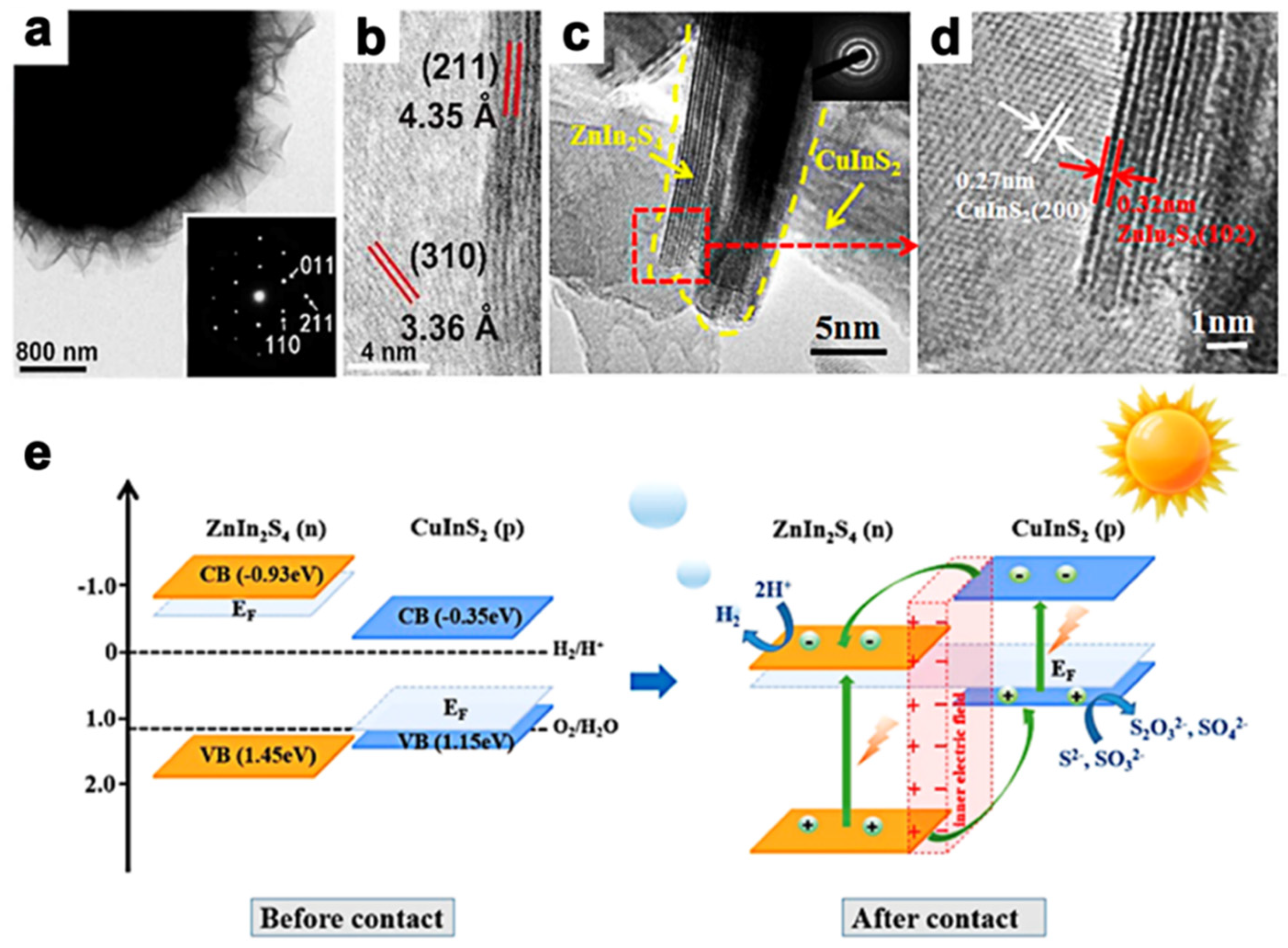
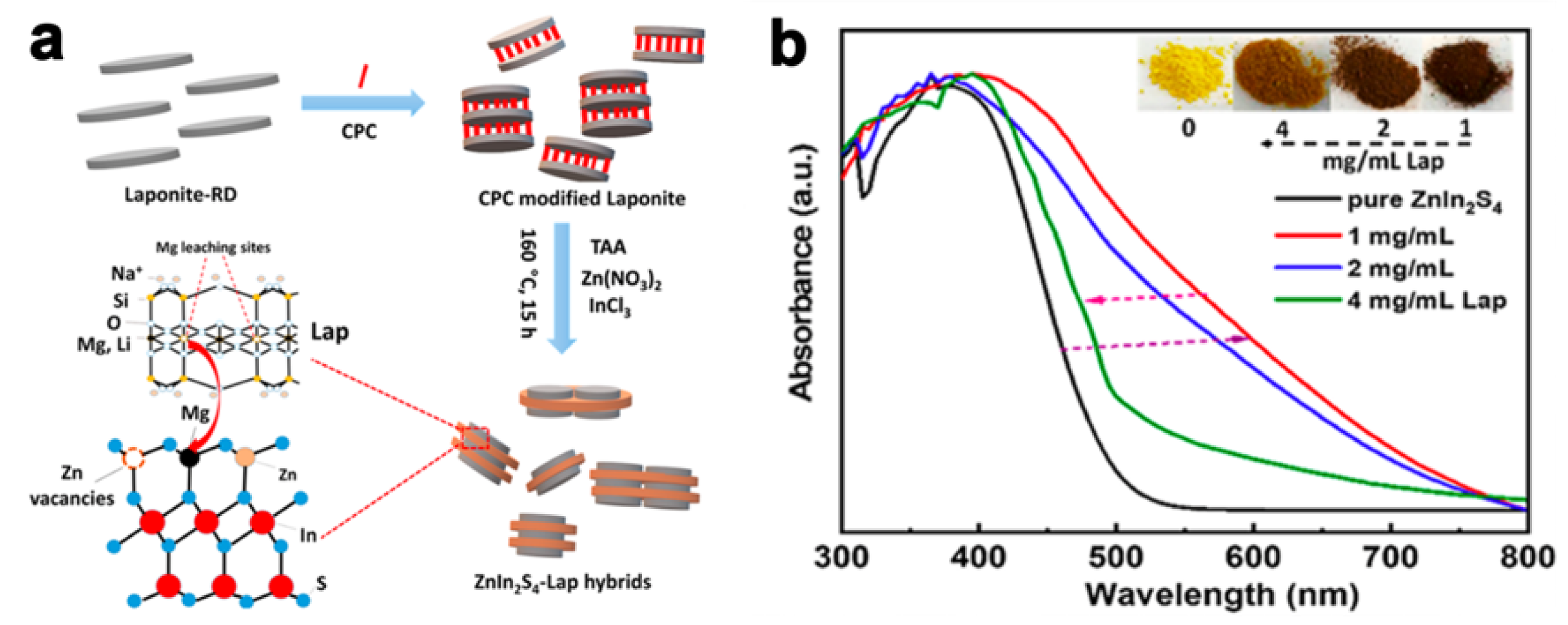
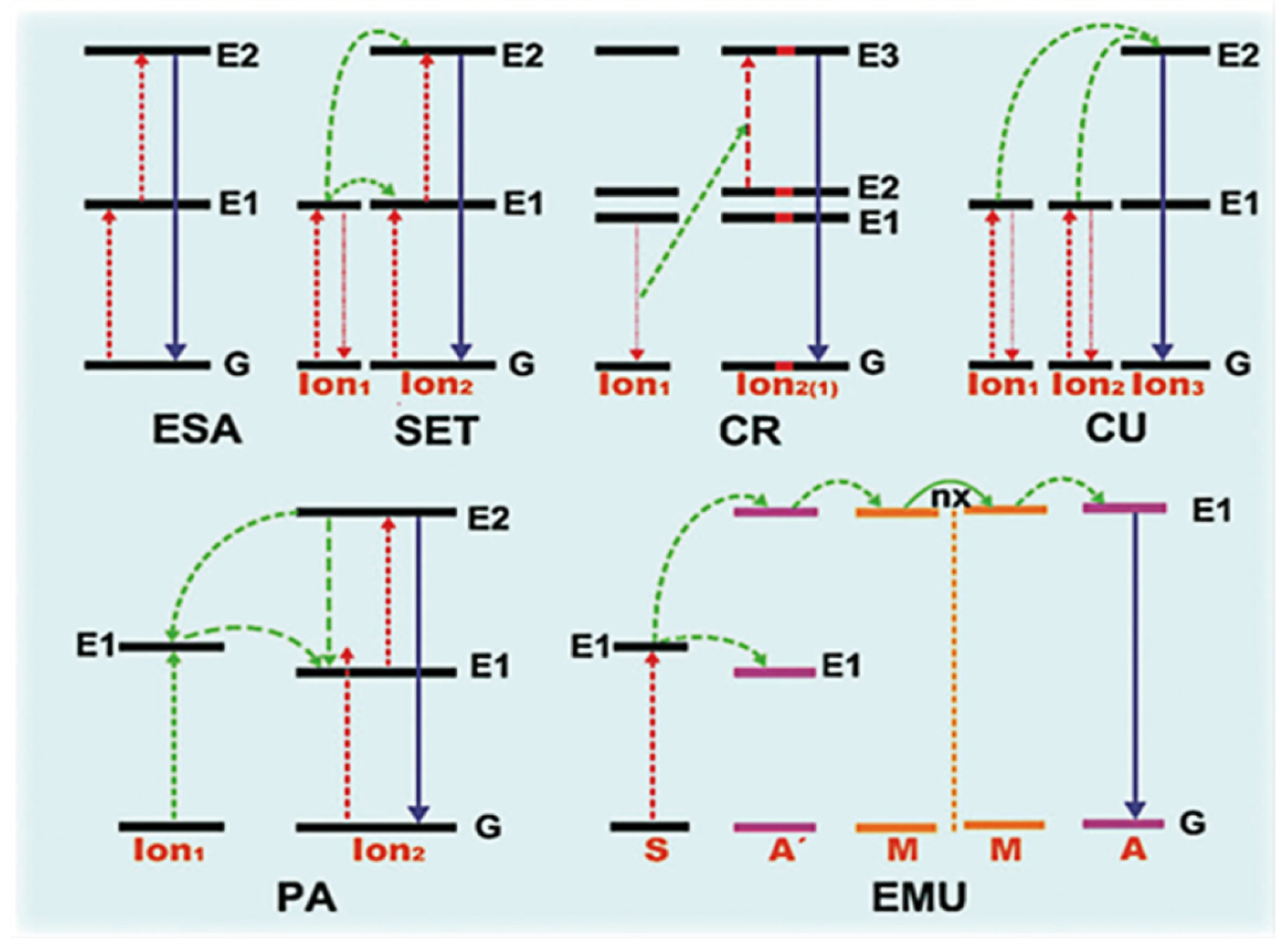
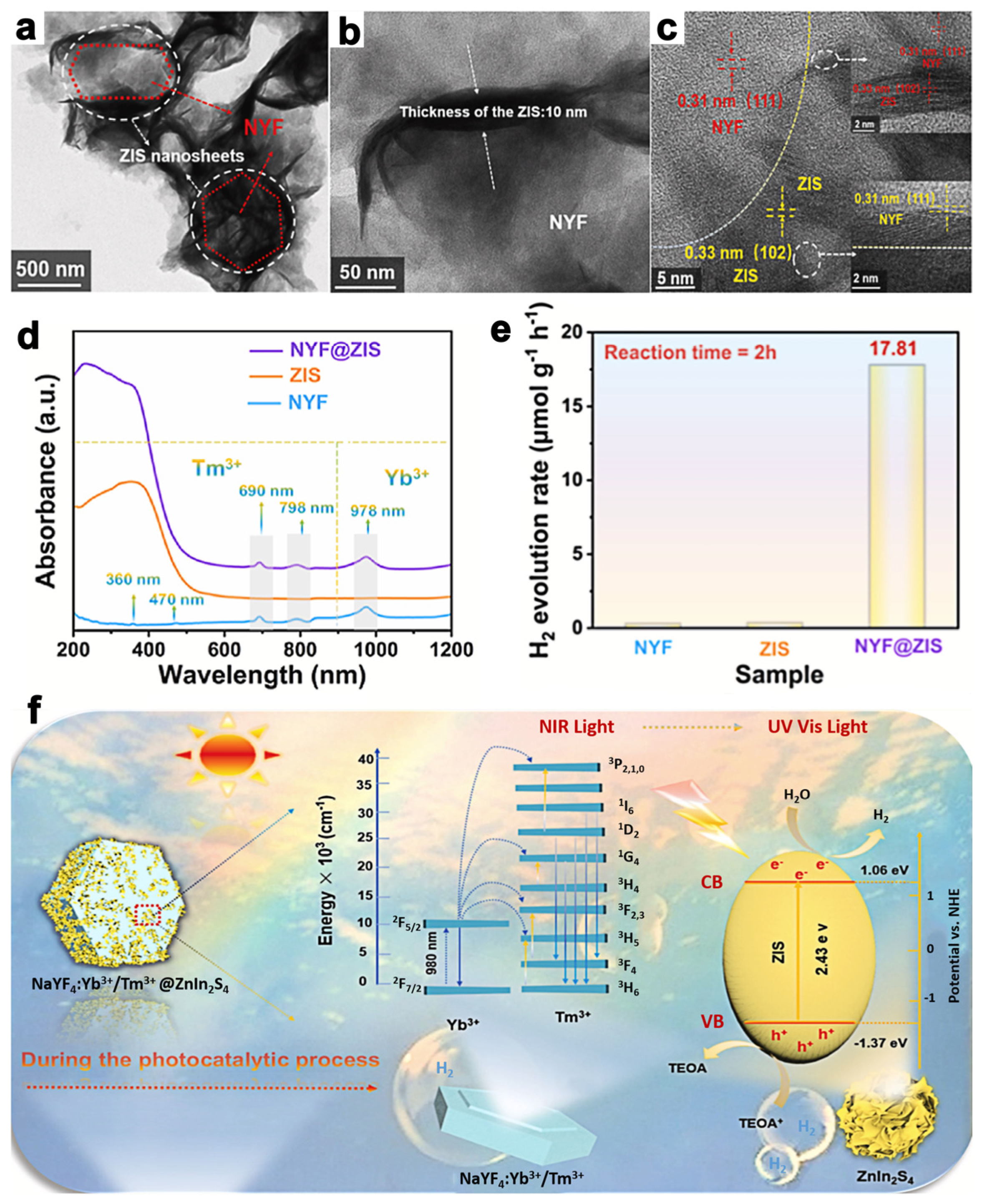


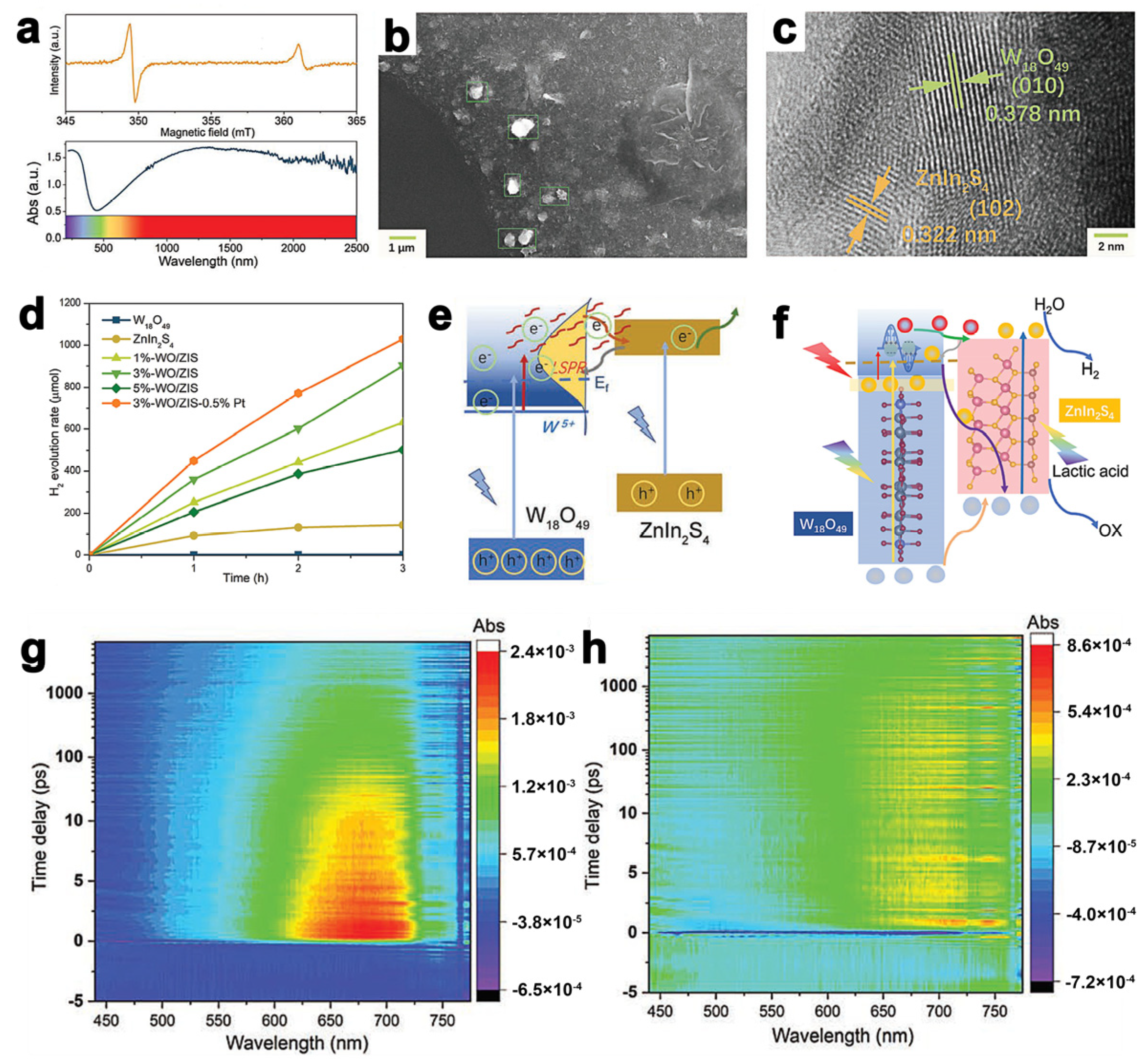
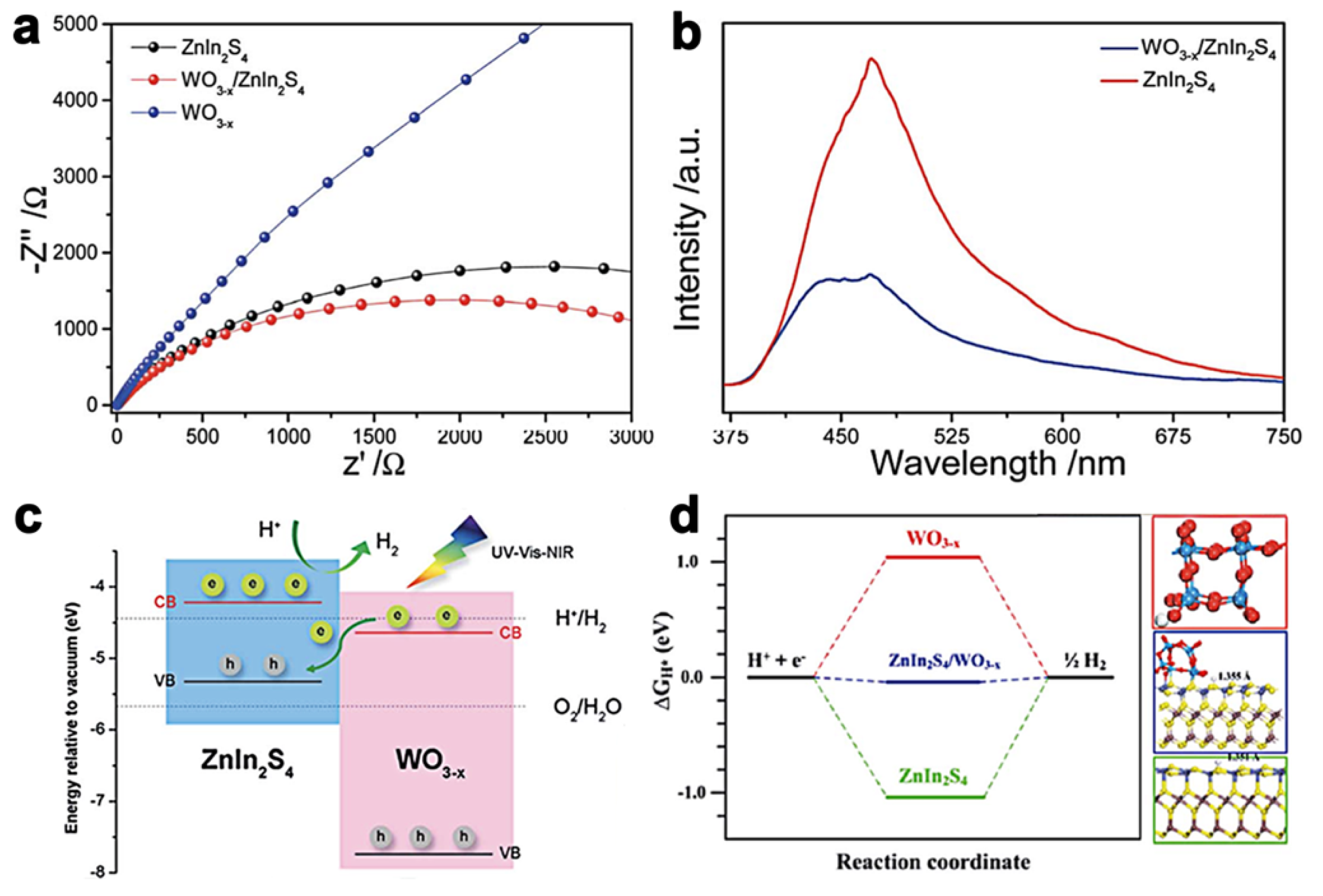

| Photocatalysts | Broadband Light Harvester | NIR Photon Capture Method | Light Source | Extended Wavelength | Application | Ref. |
|---|---|---|---|---|---|---|
| ZIS/AgIn5S8 | AgIn5S8 | Hybrid with NOGMs | 500 W tungsten halogen lamp | >420 nm | Dye degradation | [57] |
| ZIS/CuInS2 | CuInS2 | Hybrid with NOGMs | 300 W Xe-lamp | >420 nm | H2 production | [53] |
| Zn-defective ZIS-Laponite | Laponite | BGE | Visible light | 400–800 nm | Dye degradation | [54] |
| NaYF4:Yb,Tm/ZIS | NaYF4:Yb,Tm | Up-conversion effect | 300 W Xe-lamp | ≥800 nm | CO2 reduction | [58] |
| NaYF4:Yb3+/Tm3+@ZIS | NaYF4:Yb3+/Tm3+ | Up-conversion effect | 300 W Xe-lamp | <400 nm 400–800 nm >800 nm | H2 production | [55] |
| CQDs/ZIS | CQDs | Up-conversion effect | 150 W infrared lamp | N.A. | Tetracycline hydrochloride degradation | [59] |
| CQDs ZIS/BiOCl | CQDs | Up-conversion effect | 300 W Xe-lamp 150 W infrared lamp | >420 nm <700 nm | Antibiotics removal | [60] |
| WO3-x/ZIS | WO3-x | SPR | 300 W Xe lamp | 400–1100 nm | H2 production | [56] |
| K3PW12O40@ZIS/Ag2S | Ag2S | SPR | 300 W Xe-lamp | >420 nm | H2 production Tetracycline hydrochloride degradation | [61] |
| W5+–W5+ pair induced of W18O49/ZIS | W18O49 | SPR | Simulated solar light NIR light | >420 nm >700 nm | H2 production | [62] |
| Au@Pt/ZIS | Au@Pt | SPR | 300 W Xe-lamp | ≥420 nm | H2 production | [63] |
| ZIS/N-doped graphene | N-doped graphene | Photothermal effect | 300 W Xe-lamp | >420 nm | CO2 capture CO2 photoreduction | [33] |
| SnSe/ZIS | SnSe | Photothermal effect | 300 W Xe lamp | 400–1100 nm | H2 production | [50] |
Disclaimer/Publisher’s Note: The statements, opinions and data contained in all publications are solely those of the individual author(s) and contributor(s) and not of MDPI and/or the editor(s). MDPI and/or the editor(s) disclaim responsibility for any injury to people or property resulting from any ideas, methods, instructions or products referred to in the content. |
© 2023 by the authors. Licensee MDPI, Basel, Switzerland. This article is an open access article distributed under the terms and conditions of the Creative Commons Attribution (CC BY) license (https://creativecommons.org/licenses/by/4.0/).
Share and Cite
Cai, Y.; Luo, F.; Guo, Y.; Guo, F.; Shi, W.; Yang, S. Near-Infrared Light Driven ZnIn2S4-Based Photocatalysts for Environmental and Energy Applications: Progress and Perspectives. Molecules 2023, 28, 2142. https://doi.org/10.3390/molecules28052142
Cai Y, Luo F, Guo Y, Guo F, Shi W, Yang S. Near-Infrared Light Driven ZnIn2S4-Based Photocatalysts for Environmental and Energy Applications: Progress and Perspectives. Molecules. 2023; 28(5):2142. https://doi.org/10.3390/molecules28052142
Chicago/Turabian StyleCai, Yi, Fangxin Luo, Yujun Guo, Feng Guo, Weilong Shi, and Shengtao Yang. 2023. "Near-Infrared Light Driven ZnIn2S4-Based Photocatalysts for Environmental and Energy Applications: Progress and Perspectives" Molecules 28, no. 5: 2142. https://doi.org/10.3390/molecules28052142
APA StyleCai, Y., Luo, F., Guo, Y., Guo, F., Shi, W., & Yang, S. (2023). Near-Infrared Light Driven ZnIn2S4-Based Photocatalysts for Environmental and Energy Applications: Progress and Perspectives. Molecules, 28(5), 2142. https://doi.org/10.3390/molecules28052142











